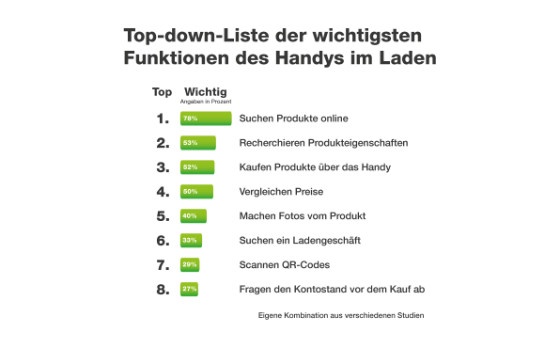Languages
Contact
CONTACT - 0049 9133 7770-800
Mobile Commerce - comparing prices and shopping online directly in store

Dominik Brokelmann, CEO
Perhaps someone has already raved to you personally about the unbelievable possibilities offered by mobile commerce or about the dramatic effects it is set to have. And perhaps you haven’t entirely understood just what all the euphoria is about, as you thought mobile commerce is the same as e-commerce, just mobile on a mobile phone instead of on a fixed PC. Basically that is right, but mobile internet and smartphones offer consumers so many more possibilities.
Smartphones make the internet mobile. The display is much smaller than on a PC, but you can access the internet and therefore online shops and price comparison portals at all times. Operating systems are becoming much more intuitive and soon virtually 100% of all mobile phones will be smartphones. Thanks to smartphones, the internet no longer stays at home or at work when you go to town, instead you take it with you in your pocket.
From a commercial point of view, the trend for mobile commerce is rising sharply. An infographic from Centre Retail Research shows that turnover with mobile devices in Europe and the USA is set to almost double, catching up on the turnover made using desktop PCs.
Recently, I have made a habit of obtaining additional information on products or checking prices online whilst in store. This function is one application which is as simple as it is brilliant. And this is the difference between mobile commerce and e-commerce. Whilst with normal e-commerce, ie using your PC at home, you need to commute between the store and your PC in order to check prices and information on the products on offer, with mobile commerce you can check the price and statements made by the sales staff with your mobile phone directly in store.
Recently I had the situation that my daughter wanted special shoes which were not available in her size in the store we were in. With my mobile phone, it was easy to find an online shop which was able to deliver these shoes. (We then ordered them there online).
If you turn down the sound on your mobile phone, you can take photos or scan the barcode of the product directly and search online, without attracting the salesperson’s attention. Before the rise of smartphones, you had to wait until you were able to access the internet again via a PC. With your smartphone, you now have a great tool in your pocket which you can use anytime and anywhere not only to find products but also to make a purchase.
You can imagine what effect this function will have on brick and mortar retailers in the next few years, when using the smartphone when shopping in store has become more established. And studies prove that consumers are not shy about using mobile phones in store. The majority of smartphone users research products online and more than half of them had already made a purchase using their smartphone in 2013.

According to the study and age group, information varies as to what users use smartphones for. In the graph above, you can see how important each of the individual smartphone functions are when used in store. I have summarised the results from four surveys in a ranking of the average importance for smartphone users independent of age and gender.
“My mobile phone is the most important shopping tool when I am in store” say more than half of the millennial generation (date of birth 1981 - 1999). Market researchers presume that this consumer behaviour will relatively quickly also become established in the older generation, facing brick and mortar retailers with the problem of how best to cope with this so-called smart shopping.
Monday, 11. May 2015 -13:57
COMMENTS































